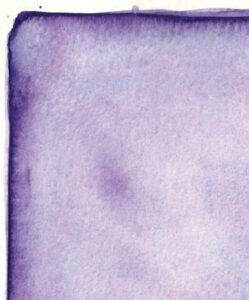
Watercolours are popular because of their simplicity, but they have a reputation for being difficult to use. Because the paint is translucent every brush mark is visible in the final result so it is essential you learn how to avoid mistakes or how to use them to your advantage – as with most things in life, prevention is better than cure
Artists of all levels often give up on a painting at the first signs of trouble which is not only disappointing after hours of work but often can also lead to the same mistake being repeated again and again. After the initial annoyance at making a mistake, it is worth spending some time thinking about what has gone wrong and how to correct it now or avoid it in the future. Painting with watercolours is often about compromise – they cannot be hammered into shape like oil or acrylic, and artists must learn to ‘go with the flow’.
What’s happened, why, and what to do about it?
 CAUSE Paint is too dark and has suddenly changed to a heavy tone. The paint mixture is too thick.
CAUSE Paint is too dark and has suddenly changed to a heavy tone. The paint mixture is too thick.
SOLUTION Try to act fast; you may be able to blot the paint off with kitchen roll immediately. If the wash has already started to dry, try to lift off as much as possible with a damp brush or kitchen roll. Don’t worry if the paint has already dried, it can still be lifted out with a damp brush, or a special Lifting Out brush or Magic Sponge.
 CAUSE A dark mix of paint has been lightened by softening or lifting out, but the edges of the shape remain dark. This problem can also be caused by overloading a thin wash of paint onto the paper, which puddles then dries with dark edges.
CAUSE A dark mix of paint has been lightened by softening or lifting out, but the edges of the shape remain dark. This problem can also be caused by overloading a thin wash of paint onto the paper, which puddles then dries with dark edges.
SOLUTION Soften the edges with a damp brush, and push the brush slightly beyond the boundaries of the shape, rather than just up to the edge. This will slightly increase the size of the shape, so changes may need to be made to the overall design.
 CAUSE Wash has been applied too slowly, brush may be too small, or possibly a dry edge has been left.
CAUSE Wash has been applied too slowly, brush may be too small, or possibly a dry edge has been left.
SOLUTION Once dry, any streaks can be smoothed out by applying a second wash – they may need scrubbing slightly whilst the paint is being applied.
PREVENTION Fill in the wash as quickly as possible, with as big a brush as possible. Chase the wet edge – fill in the centre of the wash whilst you are working around the outline, to avoid leaving any dry lines within the wash. Mix plenty of paint in the palette – you’ll probably use it later on. If you run out of paint halfway through the wash, water it down to create a ‘graded’ wash, rather than leaving a dry edge while you mix more. If the problem is persistent, try a different type of paper. You may also find it easier to paint onto wet paper, which provides a ‘cushion’ for the paint to sink into.
 CAUSE These can appear as your paint dries and are caused by an excess of water spreading into thicker paint. This can happen if you drop a light wash into thick paint when working wet-in-wet, or if you put a watery brush back into paint which has already started to dry, or if you leave puddles standing on the paper.
CAUSE These can appear as your paint dries and are caused by an excess of water spreading into thicker paint. This can happen if you drop a light wash into thick paint when working wet-in-wet, or if you put a watery brush back into paint which has already started to dry, or if you leave puddles standing on the paper.
SOLUTION Once dry, any hard ‘cauliflower’ shapes can be softened out with a damp brush or painted over with a darker wash.
PREVENTION When painting wet-in-wet, always drop dark into light. Once you’ve painted a wash, don’t fuss over it, just let the paint spread naturally without pushing it around. Watch out for puddles – these can be gently lifted with a damp brush or with kitchen roll.
 <<<‘Canal Pool in Autumn’ Illustrating how back-runs can be used to give texture to foliage, and also the use of gouache in the foreground to bring light to heavy tones and picking out the final details.
<<<‘Canal Pool in Autumn’ Illustrating how back-runs can be used to give texture to foliage, and also the use of gouache in the foreground to bring light to heavy tones and picking out the final details.
 CAUSE Too many pigments are competing with each other. The mud is often built up of several layers of paint, which are sitting so heavily on the paper it is no longer reflecting any light.
CAUSE Too many pigments are competing with each other. The mud is often built up of several layers of paint, which are sitting so heavily on the paper it is no longer reflecting any light.
SOLUTION It is possible to pull some of the mud back off the paper, but this often leads to overworking. A better solution is to paint strong dark shadows over the muddy area, but this means changes may need to be made to the overall design.
PREVENTION Limit the number of pigments you are using, and try not to mix ‘opposite’ colours together (red and green / blue and orange / yellow and purple), unless you are deliberately creating tertiary colours. Limit the number of washes you put down in any area so that the layers of paint don’t block out too much light.
 CAUSE Washes have been picked at and fussed over. Some areas have been softened out and painted over again several times. Multiple layers of paint are blocking out too much light. The surface of the paper has become damaged by too much scrubbing, or just painting too many layers.
CAUSE Washes have been picked at and fussed over. Some areas have been softened out and painted over again several times. Multiple layers of paint are blocking out too much light. The surface of the paper has become damaged by too much scrubbing, or just painting too many layers.
SOLUTION Unfortunately, painting more watercolours over the top is only going to add to the problem. Once your painting has reached this stage, it may be time to turn to mixed media. Chinese White can be used to a certain extent, but you may need something more substantial with an opaque ‘body colour’ such as gouache, pastel or acrylic, to re-introduce lightness and brightness. The watercolour then becomes a ‘background’ for a mixed media painting, which could go off in a different direction altogether.
PREVENTION Spend time planning your painting and once you have started, work with your watercolours rather than fighting them all the way.